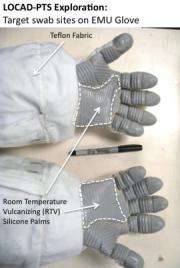ISS Spacewalkers Test Planetary Protection Concept

On March 19th, astronauts onboard the International Space Station checked themselves for microbes before stepping outside on a space walk. It was a first-ever test of planetary protection technology that, one day, could keep humans from contaminating the sands of Mars.
"We conducted the tests using LOCAD-PTS, a miniature biological lab for space travelers," explains Jake Maule, principal investigator for the experiment. LOCAD-PTS stands for Lab-On-A-Chip Application Development Portable Test System.
"Before STS-119 crew members Steve Swanson and Richard Arnold exited the International Space Station airlock to install the station's new solar arrays, astronaut Sandy Magnus swabbed their gloves with LOCAD's high-tech 'Q-tip' and then tested that Q-tip for microbes. The procedure was repeated when the astronauts re-entered the space station more than six hours later."
They ran the test, called the LOCAD-PTS Exploration experiment, because humans will one day exit a different airlock: on a spaceship on Mars. And they'll need to be sure they're not about to taint the Red Planet and its potential life forms with human microorganisms. Explorers will be intent upon bringing back pristine geological samples from Mars for analysis.
"This experiment will show how to integrate quick bio-monitoring tests of spacesuits into the very busy periods before and after EVA, when procedures need to be streamlined and efficient," says Maule. "LOCAD is quick and easy, so it can be used during those times without too much interference. It takes only about 10 seconds to swab and 15 minutes to get the results."
To lay the groundwork (literally) for the experiment, Maule and Karissa West (from Charles River Laboratories, Inc) tested 15 sites all over the S6 truss (which bears the space station's final set of solar arrays) during October and December 2008, while it was in the Space Station Processing Facility at NASA's Kennedy Space Center. They found little or no bacteria, but they did find glucan, which is a marker for fungi, at some of the 15 sites, especially on the fabric gap spanners that span the distance between handrails on the truss.
"Fabrics could be a significant source of biological contamination on the Moon and Mars and are trickier to clean than smooth metal surfaces," says Maule.
Because astronauts can't yet take a LOCAD Q-tip outside the airlock to sample individual sites on the truss as Maule and West did on the ground, they tested the spacesuit gloves instead. Members of the LOCAD team tracked the space walk, noting which handrails and gap spanners the astronauts touched. "If the crew comes into contact with a few of those gap spanners, we expect to see higher LOCAD readings (for glucan) after EVA," explains Maule.
Eventually, the LOCAD team plans to develop a special Q-tip to take outside. For now, "our goal is to see if we can monitor the gloves effectively without interfering with EVA preparation and cleanup. Those very busy times on the ISS will be even busier before a walk on the Moon or Mars."
Future Mars explorers will need to monitor and restrict biological contamination before, during, and after their outings. A spacecraft containing humans always contains plenty of biological material, and it can't all be eliminated. "Our experiment will help define acceptable levels of biological material on the surface of anything (including spacesuits) that might be taken outside of the cabin and into 'the wild.'"
That way if astronauts on Mars bring back anything from their outings that looks lively under a microscope, they'll have some idea whether it's (a) a native Martian life form or (b) a speck of weird fungi from someone's navel.
Stay tuned for results.
Source: Science@NASA, by Dauna Coulter




















